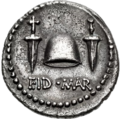English: The Republicans. Brutus. Late summer-autumn 42 BC. AR Denarius (18mm, 3.59 g, 12h). Military mint traveling with Brutus and Cassius in western Asia Minor or northern Greece; L. Plaetorius Cestianus, magistrate. Pileus between two daggers pointing downward; EID • MAR below (short for
Eidibus Martiis – on the Ides of March). Crawford 508/3; Cahn 22 (same dies); CRI 216; Sydenham 1301; RSC 15; RBW –. Good VF, deeply toned, a little off center and minor porosity on obverse. Very rare. The most famous of all Roman coins.
Marcus Junius Brutus was the son of Marcus Junius Brutus and Julius Caesar's former mistress, Servilia. By 59 BC, he acquired the alternative name Quintus Caepio Brutus through adoption by his uncle, Quintus Servilius Caepio. Brought up by Porcius Cato, he was educated in philosophy and oratory and long retained a fierce hatred of his natural father’s murderer, Pompey. He began his political career in 58 BC by accompanying Cato to Cyprus. As triumvir monetalis in about 54 BC, he issued coins illustrating his strong republican views with Libertas and portraits of his ancestors L. Junius Brutus (who overthrew Tarquinius Superbus, the last Etruscan king of Rome) and Servilius Ahala (the later fifth century BC tyrannicide) (Crawford 433/1 and 2, respectively). In 53 BC, Brutus served in Cilicia as quaestor to Appius Claudius Pulcher, whose successor, Cicero, found that ‘the honourable Brutus’ was extracting 48 per cent interest on a loan to the city of Salamis in Cyprus, contrary to the lex Gabinia.
Brutus, the principled student, stoic, and Platonist who wrote a number of philosophical treatises and poems, seems an unlikely tyrannicide, quite dissimilar to the vehement Cassius. Despite his hatred of Pompey, he followed him in the Civil War of 49 BC against Caesar, but after the former’s defeat at Pharsalus he sought and was granted Caesar’s pardon. He proceeded to enjoy Caesar’s favor and was appointed governor of Gaul in 46 BC, praetor in 44 BC and consul designate for 41 BC. Perhaps under the influence of his second wife Porcia, Cato’s daughter, Brutus joined the conspiracy against Caesar, becoming the leader alongside Cassius. The reaction of the populace in the aftermath of the Ides of March compelled Brutus to leave Rome in April 44 BC.
The Senate’s resolution to declare him a ‘public enemy’ on 28 November 44 BC was soon repealed and in February 43 BC, he was appointed governor of Crete, the Balkan provinces and later Asia. Suspecting the intentions of Antony and Octavian, Brutus went to Macedonia and won the loyalty of its governor, Hortensius, and there levied an army and seized much of the funds prepared by Caesar for his Parthian expedition. Successful against the Bessi in Thrace, he was hailed imperator by his troops, but after the establishment of the triumvirate in November 43 BC he was outlawed again and joined forces with Cassius at Sardes. In the summer of 42 BC they marched through Macedonia and in October met Octavian on the Via Egnatia just outside Philippi and won the first battle. Cassius, as his conservative coins show, remained true to the old republican cause, while Brutus followed the self-advertising line of Antony in the new age of unashamed political propaganda and struck coins displaying his own portrait. Brutus’ estrangement from Cassius was effectively complete when this remarkably assertive coin was struck extolling the pileus or cap of liberty (symbol of the Dioscuri, saviors of Rome, and traditionally given to slaves who had received their freedom) between the daggers that executed Caesar. In the ironic twist of fate, Brutus committed suicide during the second battle at Philippi on 23 October 42 BC, using the dagger with which he assassinated Caesar.
This extraordinary type is one of the few specific coin issues mentioned by a classical author, Dio Cassius, Roman History 47. 25, 3: “Brutus stamped upon the coins which were being minted his own likeness and a cap and two daggers, indicating by this and by the inscription that he and Cassius had liberated the fatherland.” The only securely identified portraits of Brutus occur on coins inscribed with his name; all others, whether on coins or other artifacts, are identified based on the three issues inscribed BRVTVS IMP (on aurei) or BRVT IMP (on denarii). A careful study of Brutus’ portraits by S. Nodelman segregates these inscribed portraits into three main categories: a ‘baroque’ style portrait on the aurei of Casca, a ‘neoclassical’ style on the aurei of Costa, and a ‘realistic’ style on the ‘EID MAR’ denarii, which Nodelman describes as “the soberest and most precise” of all.




